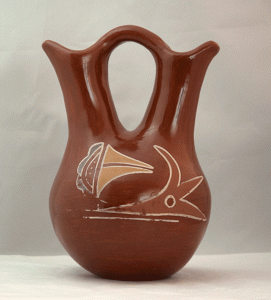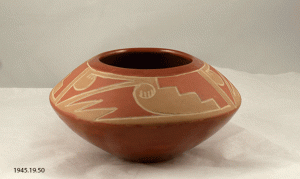The Gutierrez Family are potters from San Clara. The museum collection has a pot by Lela and Van Gutierrez. Tonight has I was doing some research I found that Van’s birth name was Evangelio, he went by Van. The couple had seven children: Cleto, Louis, Juan B., Margaret, Juan, Avelio, and Luther. Their daughter Margaret shared this about her parents and her brother, “They are the first who did the colors. I don’t know how they came up with it–I never asked them. I guess by trial and error they came out with these colors–picking, clays and seeing what works and what doesn’t work. Mom and dad worked together, then Luther painted for her [during and after Van’s death], and after she passed away I took over. After Luther passed away, I signed the pottery by myself. My dad and Luther overlapped with painting.” Maria travels to places like the Grand Canyon, Denver, La Bajada, and Los Alamos to get clay for her pots (Dillingham, 1994).
When I started my journey as an intern “Lela/Van” were just names noted on a piece of paper in the accession folder for a particular vessel. Then I confirmed that they were potters from Santa Clara whose names were Lela and Van Gutierrez. These two potters came to life for me when I actually got to see the pot they had made up close and then I saw their signature on the bottom of the pot…I felt like this pot had a story to share! When I read what Margaret said about her parents and I found Van’s birth name, the Gutierrez family story was started to blossom before me.
Click on the Santa Clara tab to see a picture of the pot that Lela and Van made and signed. I have a photograph posted of Lela and Van on my blog entry titled, “Potters”.
BIBLIOGRAPHY
Dillingham, Rick. Fourteen Families in Pueblo Pottery. The University of New Mexico Press. 1994.


